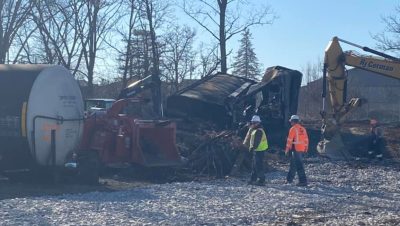Ohio Disaster: When Hedge Funds Manage Rail Traffic

All Global Research articles can be read in 51 languages by activating the Translate Website button below the author’s name (desktop version)
To receive Global Research’s Daily Newsletter (selected articles), click here.
Follow us on Instagram and Twitter and subscribe to our Telegram Channel. Feel free to repost and share widely Global Research articles.
***
After the derailment of a freight train loaded with highly toxic chemicals in the US state of Ohio, a devastating environmental catastrophe may now be imminent. The wagons burned for days, and a “controlled” explosion by the authorities released dangerous gases into the environment.
*
A dark cloud of smoke could be seen from afar. The residents who were brought to safety are now allowed to return to their homes. But they all reported skin and respiratory irritation and numerous dead animals.
About 50 wagons of the freight train, some of which were loaded with the carcinogenic vinyl chloride and other chemicals, derailed on February 3 in East Palestine, Ohio. Several of the tankers caught fire. To prevent an explosion, local authorities decided to release the vinyl chloride. Now there are fears of a large-scale environmental disaster, which could affect the region’s drinking water supply in particular.
Environmental disaster
The US Environmental Protection Agency (EPA) said state and local agencies are taking samples throughout the Ohio River “to ensure drinking water abstraction points are not affected.” At the same time, they tried to reassure the population that there was no acute danger to life. However, environmentalists warn that burning vinyl chloride releases hydrogen chloride and phosgene. The latter served as a chemical warfare agent during World War I. In Ohio, it is feared that these substances have settled in groundwater and soil.
There has also been strong criticism of the safety precautions that are apparently too lax. The accident train is said not to have been equipped with electronic pneumatic brakes. Worse still, according to Ohio Governor Mike DeWine, the train was not marked as dangerous goods.
Biden administration also responsible for gross neglect
US commentators also point to a possible link between the train disaster and the ongoing conflict between US railroad workers’ unions and the Biden administration.
The unions have been on strike for months, one of the main reasons being rationalization measures associated with the acronym PSR: Precision Scheduled Railroading. According to railroad workers, PSR results in fewer staff, less maintenance, fewer vacation days, longer trains and questionable business practices, with railroad companies being forced to keep their trains moving as much as possible for profit reasons.
This is how far the deadly plume from East Palestine, OH had traveled by Feb. 8.
NOAA has since shut down access to this website. pic.twitter.com/YXtTbYh0i8
— Stew Peters✝️🇺🇸 (@StewpeterUSA) February 17, 2023
Hedge funds implicated
Many of the larger US railroads are managed by large hedge funds and financial investors such as Vanguard, JP Morgan and BlackRock, as is the Norfolk Southern Railway, one of the major railroad companies east of the Mississippi River.
According to some sources, Norfolk Southern has since been trying to pay affected residents $1000 “inconvenience” fees because they have been exposed to dangerous, toxic carcinogens. BlackRock and Vanguard will try to use it as a waiver of all future claims, they say.
The disaster train, traveling from Illinois to the Conway station on February 3, ran over a sensor that detects heat on the train’s wheels and axles and reported that the wheels were on fire. What is now known is that instead of stopping to inspect and repair the damage, the train crew was instructed by the dispatcher to proceed towards Conway, allowing the train to travel 20 miles at a speed of 30 kilometers per hour to East Palestine Station.
Meanwhile, the wheels overheated. Videos from surveillance cameras have now surfaced online showing sparks flying from some of the overheated wagon axles. Some of the cars derailed, causing a fire.
Most farms in Idaho are family owned
Federal data released in January 2022 by USDA’s National Agricultural Statistics Service, showed that ninety-six percent of the 25 000 farms in Idaho are family owned, adding to concerns about the the future of their livelihoods as the Ohio basin provides water to 5 million residents.
The data was gathered from the 2017 Census of Agriculture. “For consumers, that means most of the food products they buy were produced by families just like theirs,” said Idaho Farm Bureau Federation President Bryan Searle.
“We farm potatoes, sugar beets, wheat and children, but not in that order; the children come first,” one farmer explained. “It’s a very family-oriented operation. When it comes time for planting or harvesting, we’re all involved. We all climb in different trucks and tractors, all the wives and kids. We’re all involved in it.”
Highlights from the NASS report
Small family farms (with gross cash farm income, or GCFI, of less than $350 000 per year) account for 45 percent of all direct sales to consumers, compared to 17 percent for mid-size family farms (GCFI between $350 000 and $999 999) and 23 percent for large-scale family farms (GCFI of $1 million or more).
The majority of small family farms specialize in cattle (34 percent) or “other crops” (23 percent). More than half (53 percent) of mid-size farms specialize in grains and oilseeds. Large-scale family farms vary more in product specialization, although they are more likely than other family farms to specialize in dairy production or specialty crops.
*
Note to readers: Please click the share buttons above. Follow us on Instagram and Twitter and subscribe to our Telegram Channel. Feel free to repost and share widely Global Research articles.
Featured image: Contractors removing the burnt wagons, East Palestine, Ohio. (Facebook via Free West Media)

